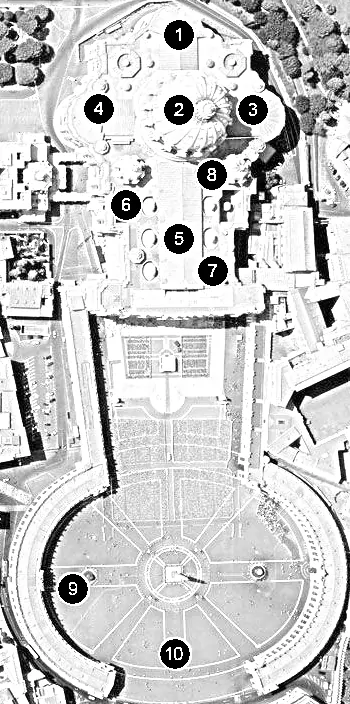Papal Basilica of St. Peter
The exact spot in the Circus Maximus of the crucifixion of St. Peter was preserved by tradition. It is in the present Church of St. Peter, marked by an altar.
Introduction
The present Church of St. Peter stands upon the site where at the beginning of the first century the gardens of Agrippina lay. Her son, Caius Caligula, built a circus there, in the spina of which he erected the celebrated obelisk without hieroglyphics which was brought from Heliopolis and now stands in the Piazza di S. Pietro. The Emperor Nero was especially fond of this circus and arranged many spectacles in it, among which the martyrdoms of the Christians (Tacitus, "Annal.", XV, 44) obtained a dreadful notoriety. The exact spot in the circus of the crucifixion of St. Peter was preserved by tradition through out the centuries, and in the present Church of St. Peter is marked by an altar. Directly past the circus of Nero ran the Via Cornelia which, like all Roman highways, was bordered with sepulchral monuments. In Christian times a small city of churches and hospices gradually arose here, but without this part of Rome being included in the city limits. When in the year 847 the Saracens pillaged the Basilica of St. Peter and all the sanctuaries and establishments there, Leo IV decided to surround the extensive suburb with a wall, interrupted at intervals by exceedingly strong and well-fortified towers. Two of these towers, as well as a fragment of the wall, are still preserved in the Vatican gardens and afford an interesting picture of the manner of fortification. Owing to this circumvallation by Pope Leo the Vatican portion of the city received the name Civitas Leonina, which it has preserved to the present day (Leonine City). The Vatican Hill rises in close proximity to the river Tiber. Between it, the river, and the mausoleum of Hadrian (Castle of Sant' Angelo) lies a small plain which was not filled with houses until the early Middle Ages. The Vatican territory did not assume a throughly urban character until the end of the fifteenth century.
Click on a link to the Vatican website beginning a virtual tour.
| 1. | Apse |  |
| 2. | Altar | |
| 3. | North Transcept | |
| 4. | South Transcept | |
| 5. | Nave | |
| 6. | Choir Chapel | |
| 7. | Pieta | |
| 8. | Altar of St. Jerome | |
| 9. | St. Peter's Square 1 (Night) | |
| 10. | St. Peter's Square 2 (Night) | |